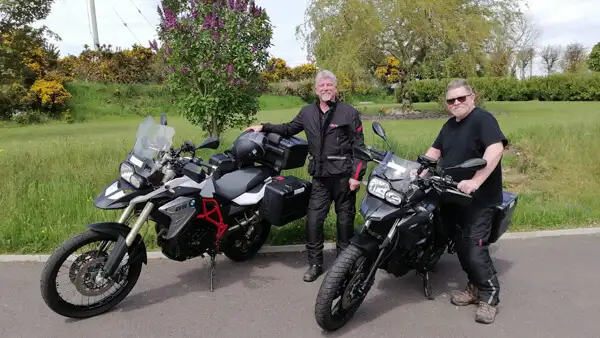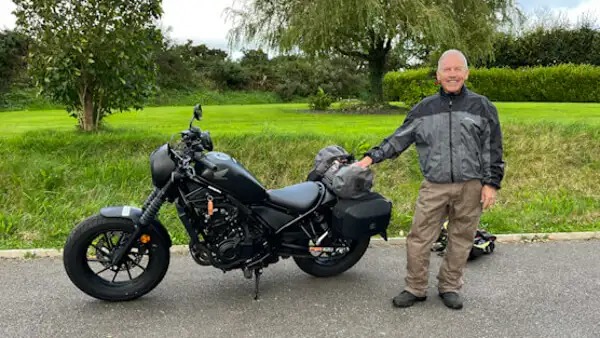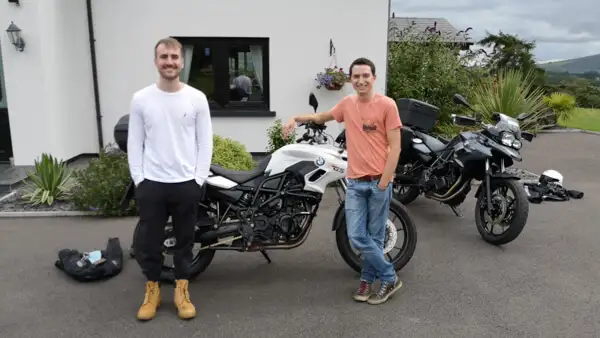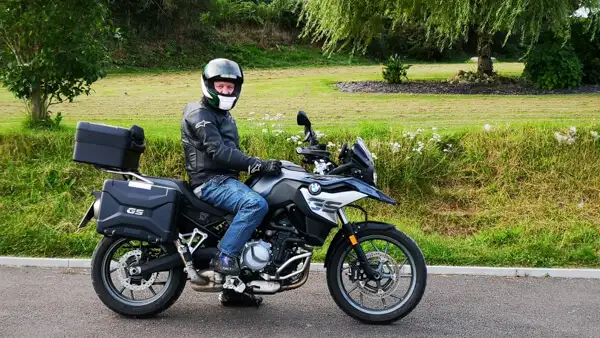Are you one of those motorcyclists who always take too much stuff with them – and then leave the most important things at home?
Page Contents (click line to jump the text)

Intro
Don’t worry, you’re not alone – and I got you covered.
Below I have lots of good tips on packing and luggage for motorbike touring. I’m referring to Ireland here, but you can use my tips for Scotland and many other regions in Northern Europe.
I have travelled a lot by motorbike, especially in Ireland and the British Isles, but also in several other European countries. My family and I are from Germany, but have lived in Ireland (second home) for several years.
At our location, south of Dublin, we did run our own motorbike rental business over many years.
But now for your motorbike packing tips:
Pack simply – less is more
Motorcycling is an outdoor activity: we bikers feel the fresh air, the sun, but also the rain and the wind directly. If you think of mountain hiking or cycling tours when you think of motorbike tours, you’re not wrong at all, because the requirements for clothing and equipment are similar:
We want to be well equipped for any weather with a small packing volume in order to enjoy the holiday safely and comfortably. Overheating, undercooling and getting wet pose a not inconsiderable health and safety risk. Fortunately, there is excellent clothing to protect us against these.
Perhaps the most important tip: you need much less than you think – luggage weighs you down – sorting out frees you up!

Clothing and motorbike gear
The most important equipment is sensibly put together and high-quality clothing. If you combine several thin layers (onion principle), you can flexibly adapt to different weather conditions and stay cool, warm or dry as needed.
In doing so, you don’t need to take very much clothing at all and save scarce packing volume in your pack sacks.
My recommendations for you:
Functional underwear: Made of synthetic fibre or blended fabric – wicks moisture to the outside and dries quickly. Think about the whole body: Long functional pants and functional shirt, good warm socks or stockings made of textile fibre, blended fabric or wool (no cotton). If you do sports, you may already have sports T-shirts or leggings made of synthetic fibres – these also work for motorcycling, as do hiking underwear or ski/hiking socks.
Middle layer: Fleece or microfleece shirts or jumpers combined. The middle layer of clothing should be as breathable as possible to minimise sweating and allow moisture to be transported to the outside.

Helmet: In summer, especially on day tours (star tours), the jet helmet (with full visor because of rain) is nice and airy. At the latest when it gets cool, the full-face helmet offers more protection and warmth on long tours. Half-shell helmets without visors are not recommended.
Boots and gloves: Good motorbike boots and gloves with a reliably waterproof functional membrane help in the rain. The boots should be comfortable enough to go for short walks and explorations during the tour.
It is highly recommended to take two pairs of gloves with different thicknesses, then you remain flexible. There are also rain covers for boots and gloves, but I have not had good experiences with them because they are a hassle to put on and take off and do not wear well.
Motorbike suit: The normal jeans and denim jacket are not recommended for motorbike trips! More suitable (in summer) are motorbike jeans or motorbike leather trousers with motorbike leather jacket including protectors. To protect yourself from possible wetness, we recommend the motorcycle-textile combination, especially on round trips.
A good all-season textile combination with a really reliable waterproof functional membrane and releasable inner lining is the best choice for all our tours, but is usually not cheap. A good and much cheaper alternative is then a cheap textile suit (which is then usually not completely waterproof) in combination with a very cheap (completely waterproof) rain suit. Two-piece suits are more practical than one-piece suits.
Before and after the ride: Almost everyone takes too much clothing here. A pair of trainers or trainers (with a small pack size), one (maximum two) pair of comfortable city trousers and one (maximum two) jumper/sweater combined with a light softshell jacket or hiking jacket – and you are ready for the journey to and from the hotel or restaurant on the way or for a visit to the city. There is also a washing machine and dryer in the holiday home/guesthouse…
You can also rent a complete set of clothing from us. This consists of a flip-up helmet, motorbike suit, motorbike boots and gloves, kidney belt and a rain suit.
By the way, in the picture gallery above you can see three customers in rental motorbike suits and another three customers with rental helmets and rental rain suits (over the rental suit).
Luggage
This is how you get a feel for motorbike luggage: All our rental touring enduros have 2 side cases with more or less 35 litres per side or 70 litres in total. In addition, there is a top case with a volume of about 30-40 litres. So in total about 100 litres per bike.
For comparison, a typical aeroplane carry-on has about 50 litres. If space is tight with two people on the bike, we can also provide an additional tank bag.
Our cruisers and smaller enduros have soft bags with about 20 litres per side and a top bag with another 30-50 litres. That’s easily enough for one person (and these bikes aren’t designed for two).
So if you calculate with a typical airplane carry-on suitcase per person, your luggage will usually fit on any motorbike.
Other important items
Identity documents: In Ireland (EU) an identity card is sufficient, for Northern Ireland and Scotland (UK, no longer in the EU) a passport is recommended.
Driving licence: If you do not have a valid driving licence for the motorbike you are renting, we cannot rent you a motorbike – so please bring your driving licence with you!
Credit card / debit card: In Ireland, Northern Ireland and Scotland you can usually pay with most bank cards in most shops. Caution: Not all automatic petrol stations accept every card. VISA is usually problem-free in our experience. Several bank cards are therefore an advantage.
Cash: A little cash won’t hurt – in Ireland the EURO is the currency, in Northern Ireland and Scotland the currency is the British pound. You don’t need to bring pounds with you, ATMs can be found in most towns and on the ferries and you can pay for almost everything by card anyway.

Electrical equipment: Be sure to take a handy camera if you have one – or even your smartphone with its chargers. In Ireland, Northern Ireland and Scotland, three-pin UK sockets are used (230V). You can easily buy a travel adapter before you leave.
Medicines: Generic medicines are available in every pharmacy. But if you need certain medicines regularly, bring them with you in sufficient quantity – it can be difficult to find them on the road.
Cosmetics: Keep your toiletry bag as small as necessary: a hairdryer is available in almost every hotel (and in our guesthouse) and most cosmetics can be bought in very small pack sizes. You can easily buy the usual cosmetics or drugstore items when you’re out and about.
Mosquito spray or creams: In Scotland, there can be annoying midges in summer, which are very small biting flies. If you want to be on the safe side, take mosquito repellent and a head covering with you. In Ireland, this is practically not an issue.
Sunglasses and hat/cap? Yes, absolutely – it’s not all rain!
Neckerchief / bandana, balaclava, heat collar: A stiff neck is unpleasant – these little helpers are a great comfort gain.
Packing tips
A few more recommendations for packing:
You should always have easy access to your rain gear, e.g. in the top case together with spare gloves.
Leave a little space in the top case for food and drink: a water bottle, some fruit or muesli bars, a sandwich are always helpful in between to stay fit and in good spirits.
Map, guidebook, sunglasses, mosquito repellent, cap, bandana, camera, valuables – you should also be able to reach all of these easily.
Valuables: Never leave valuables on the bike – in your jacket or a small extra pocket (hip pocket, soft small handbag, small soft rucksack) well stowed, you can take them with you quickly and easily at every stop.
Separate wet and dry: For example: the rain suit and spare gloves in one side case, the camera and important papers in the other case.
And if the suitcase won’t close? Then you still have too much luggage with you – unpack everything you don’t absolutely need! 🙂
Have fun packing and have a good trip!
More interesting articles for you
HOW MUCH DOES A MOTORBIKE HOLIDAY COST IN IRELAND?
THE 13 MOST BEAUTIFUL MOTORBIKE TOURS ON THE IRISH ISLAND
MOTORBIKE HOLIDAYS IN IRELAND – THE 14 MOST BEAUTIFUL CLIFFS ON THE WILD ATLANTIC WAY
56 TIPS FOR PLANNING AN UNFORGETTABLE MOTORBIKE TRIP IN IRELAND!
Photo credits cover photo: Motorbike and rider perfectly ready to go on tour, photo by Ulrich Knüppel-Gertberg (www.irland-insider.de, www.ireland-insider.com)